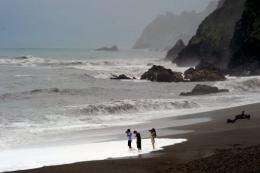Vistors photograph the ocean near the Nanfangauo fishing harbor in Ilan county, eastern Taiwan in May 2011. Taiwan said Monday it had put into service its first undersea seismic observation system, giving the island life-saving extra seconds or even minutes to brace for earthquakes and tsunamis.
Taiwan said Monday it had put into service its first undersea seismic observation system, giving the island life-saving extra seconds or even minutes to brace for earthquakes and tsunamis.
The Tw$420-million ($14-million) system, built by Japan-based NEC Corp, consists of equipment ranging from ocean-bottom seismographs to tsunami pressure gauges and even underwater microphones.
"The system gives a much clearer picture of what's happening. We can even hear the sounds of dolphins swimming by," Kuo Kai-wen, director of the Seismology Centre, told AFP.
"With the help of this system, we'll be able to attain an average of 10 seconds' extra warning if earthquakes hit off the east coast, and an extra 10 minutes to issue tsunami warnings," he said.
Taiwan is regularly hit by earthquakes, as it lies near the junction of two tectonic plates. In September 1999, a 7.6-magnitude tremor killed around 2,400 people in the deadliest natural disaster in the island's recent history.
The new alert system is centred around a submarine cable beginning at the township of Toucheng in the northeast of Taiwan and stretching for 45 kilometres (27 miles) into the ocean in a roughly easterly direction.
Nearly 70 percent of the earthquakes that strike Taiwan hit this area, according to the seismology centre.
The system is deployed at a depth of around 300 metres (990 feet), sending real-time digital information to land via submarine optical fibre cable 24 hours a day, NEC said in a statement.
Taiwan began considering an undersea alert system after the Indian Ocean tsunami in late 2004 killed almost a quarter of a million people.
Another undersea earthquake, as powerful as that which caused the 2004 disaster, triggered a tsunami that struck Japan in March, leaving about 22,000 dead or missing.
"The power of the two quakes was pretty much the same, but the much lower toll figure in Japan shows that early warning systems are very effective in the battle against unexpected natural disasters," Kuo said.
(c) 2011 AFP
























